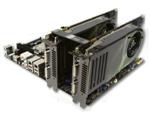 Coke or Pepsi? Intel or AMD or in this case ATI or NVIDIA? It’s all about choices. Like always, the competition is fierce between the Santa Clara based NVIDIA and the red team from Ontario. This time it’s NVIDIA’s turn, they just released their GeForce 8800 series, signifying, you guessed it, another speed increase. Though, I’m left wondering what they are going to do after the 9xxx numbers are used. NVIDIA has come a long way from the old GeForce FX 5800 ‘Dustbuster’ days, remember that one? The GeForce 8800 series is getting a lot of attention due to its lead over ATI in many graphics benchmarks, in some cases beating ATI’s cards in a Crossfire setup. But as usual, you don’t get to keep the performance crown that long in the graphics world, as either ATI or NVIDIA are always cooking up something to dethrone the other.
Coke or Pepsi? Intel or AMD or in this case ATI or NVIDIA? It’s all about choices. Like always, the competition is fierce between the Santa Clara based NVIDIA and the red team from Ontario. This time it’s NVIDIA’s turn, they just released their GeForce 8800 series, signifying, you guessed it, another speed increase. Though, I’m left wondering what they are going to do after the 9xxx numbers are used. NVIDIA has come a long way from the old GeForce FX 5800 ‘Dustbuster’ days, remember that one? The GeForce 8800 series is getting a lot of attention due to its lead over ATI in many graphics benchmarks, in some cases beating ATI’s cards in a Crossfire setup. But as usual, you don’t get to keep the performance crown that long in the graphics world, as either ATI or NVIDIA are always cooking up something to dethrone the other.
The GeForce 8800 series codenamed G80 is DirectX 10 compliant and comes in two flavors: GeForce 8800GTX and 8800GTS.
The 8800 GTX card has all architectural features enabled, including the 128 stream processors running at 1.35GHz, the GPU clocking in at 575MHz and a 384-bit path to memory. The amount of built-in memory is an amazing (for graphics cards at least), 768MB of Samsung GDDR3 clocked at 900MHz (1800MHz effective being DDR). This card will be priced at $599, but you can expect higher prices then the suggested MSRP. For those of us with less money to burn, NVIDIA also created the 8800 GTS variant featuring a 500MHz GPU, 1.2GHz stream processors, 640MB of GDDR3 memory running at 800MHz, and the same set of output ports and capabilities as the GTX. The GTS is basically uses a cut-down version of the G80 with some units disabled, equipped with 96 stream processors, five ROP partitions, and a 320-bit memory path. All these lesser capabilities can be seen in the lower price of $449.
The GTS variant might offer lesser performance but it offers something that GTX can’t: a shorter board and less power-hungry. The GTX will actually need dual six-pin PCIe power connectors not to mention that it looks absolutely huge!!!
A new graphics card from NVIDIA also signifies getting a new mascot. It started with the now famous Dawn demo and it continued with Nalu the mermaid and the high priestess Luna. With the 8800 series they are now using Adrianne Curry, a real-life model. The previous tech demos used fictional characters.


The Architecture

NVIDIA played it safe with this design by using the tried and true 90nm process; this allows for increased yields, but on the other hand you get a very large chip.
The G80 architecture that the 8800 series is based on uses a unified architecture that merges both vertex and pixel shaders into a single tank of floating-point processors.
On the simplified diagram of the G80, the green squares are the Stream processors; the G80 has a total of 128 on the GTX version. Unlike in traditional architectures the stream processors aren’t vertex or pixel shaders, but generalized floating-point processors capable of operating on vertices, pixels, or any type of data that it gets thrown at it. These Stream Processors operate at an astonishing 1.35GHz.
Below the Stream Processors we find the ROP partitions with their L2 cache. These ROP partitions have in total a 384-bit path to memory. Also noteworthy is the fact that NVIDIA chose a separate chip to drive displays
I also expect a slew of lower priced midrange and low-end cards based on this architecture to appear soon.
Written by Devin

